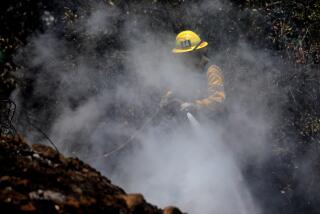Typical RTD Driver Out 32 Days a Year
- Share via
Pointing to more employee problems at the Southern California Rapid Transit District, a new independent audit has found that absenteeism among bus drivers is worse than previously reported.
Every day, an average of 13% of RTD bus drivers are away from their jobs on unscheduled absences--costing the transit agency $18.6 million a year, according to an RTD summary of the audit released Tuesday.
The full audit, which was prepared for the Los Angeles County Transportation Commission, will not be made public until Thursday. The commission oversees a significant share of RTD’s operating funds.
Earlier this year, a national report had revealed that the daily RTD driver absentee rate was 11.5%, compared with about an 8% rate at comparable large bus systems in New York, Washington and Chicago. At the time, RTD officials strongly disputed the accuracy and comparability of those figures. The new report, however, shows the situation to be even worse.
On average, the typical RTD driver is absent about 32 days per year, not counting vacations, holidays, military leave and instruction, the new report says. However, 20% of the drivers average 81 days of unexcused absences a year, the audit found.
Other service and maintenance employees of the RTD averaged 20 to 30 days of unscheduled absences a year.
“Absenteeism represents a significant leakage of resources from the district’s bus system,” RTD General Manager John Dyer said in a letter to transit district board members. “The result is a ‘manpower shortfall’ necessitating overtime work and the payment of premium wages.”
A preliminary Transportation Commission report earlier this year on the problem had estimated that up to $3.8 million a year could be saved by a modest improvement in the absentee rate. But the new report, based on more detailed analysis by the San Francisco-based consulting firm of Price Waterhouse, has “conservatively” estimated that $6 million can be saved, according to Dyer’s report.
Further, the report found that the provisions of union agreements with bus drivers and mechanics appear to be encouraging drivers to skip regular work days and volunteer for work on days off at a time-and-a-half rate, Dyer reported. And a comparison of union contracts with other large-city transit systems found that the RTD’s “program of progressive discipline is less restrictive,” he added.
At a board meeting Thursday, Dyer will ask for authorization to reopen multi-year labor contracts with bus drivers and mechanics to try and increase the controls on the absenteeism.
Dyer and top Transportation Commission officials were out of town at a transit conference Tuesday and could not be reached for comment.
But county Supervisor Kenneth Hahn, who has been critical of RTD management during the recent wave of reports of safety problems, drug abuse and licensing problems among drivers, called the new statistics “unbelievable.”
“I think Dyer is a good manager, but he has to tighten down his ship. The whole operation is too loose,” Hahn said.
Earl Clark, general chairman of the bus drivers’ union, said, “There is no question that the district has an absenteeism problem,” and added that he could not dispute the audit’s findings.
Cites Manpower Shortage
But he claimed that absenteeism is exacerbated by district management overworking drivers. Citing district records for the week ending Sept. 20, Clark said 311 operators were required to work on days off and another 535 drivers filled slots voluntarily.
“If that’s sufficient manpower, then something is wrong,” he said. “If the district wants to talk to us about absenteeism, they’ve got to clean up their own act first and get proper manpower and get sufficient service.”
He agreed that drivers may be taking regular days off and working their scheduled days off at premium rates but said that too could be resolved if the district had an adequate number of drivers.
District officials have argued that if absenteeism were reduced the manpower shortage would also decline.
Still, the district acknowledged earlier in the year that it had let its active duty force of drivers--now at about 4,700--shrink too far. A spokesman said Tuesday that there has been a net increase of about 160 drivers since the beginning of the year, and the district is trying to add another 70.
More to Read
Sign up for Essential California
The most important California stories and recommendations in your inbox every morning.
You may occasionally receive promotional content from the Los Angeles Times.













